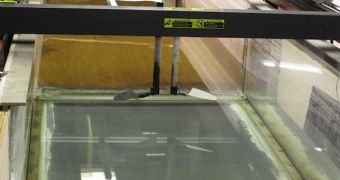Researchers at a national laboratory in the United States are currently investigating the flight of hummingbirds using a set of robotic wings, that have been developed in such a manner that they are capable of replicating most features that the diminutive birds have naturally.
Though they are not brightly-colored, and have no iridescent glow of their own, the metal wings are being heralded as the first step towards understanding the peculiarities of hummingbirds' flight. These creatures can fly, hover and dive through the most severe weather conditions.
Other birds cannot do this, and so researchers want to understand the flight physics and the mechanics that this particular species uses to underlie its abilities. The artificial, metal wings were developed by expert B.J. Balakumar.
The expert holds an appointment as a researcher in the Extreme Fluids Lab, which is based at the US Department of Energy's (DOE) Los Alamos National Laboratory (LANL), in New Mexico.
He explains that the hummingbirds were selected because they are some of the largest hovering animals in the world. This may appear counter-intuitively, since the largest member of this species weights some 20 grams (0.7 ounces).
But what makes these birds able to hover is the fact that they don't use a normal type of wing flap. Rather than moving their wings up and down only, this species generates an 8-like pattern in the air.
This in turn allows the hummingbird to generate lift on both the upstroke and the downstroke. Additional lift is generated by a vortex of air that is produced alongside the leading edge of the wings, LiveScience reports.
But what Balakumar and his team found was that these vortices were very unstable. At even the smallest disturbance, they simply vanish, and so the researchers became interested in how the hummingbirds moved past this issue.
“Their wings create the vortex with a high angle of attack on the downstroke. Then they flip their wings around on the upstroke, so as they shed one vortex, they create another on the other side of the wing, thereby managing to maintain high lift forces,” the expert explains.
But even this explanation raised another problem. This delicate balance of vortices that the bird creates around its wings can be upset by winds, and yet the hummingbirds remain aloft and hovering in windy conditions.
The goal of the newly-developed robotic winds is to determine how this is possible. Using mathematical algorithms, the LANL team plans to transfer the knowledge they will obtain to flying robots.
Details of the new studies were presented in Long Beach, California yesterday, November 21, at the meeting of the American Physical Society's (APS) Division of Fluid Dynamics.

 14 DAY TRIAL //
14 DAY TRIAL //